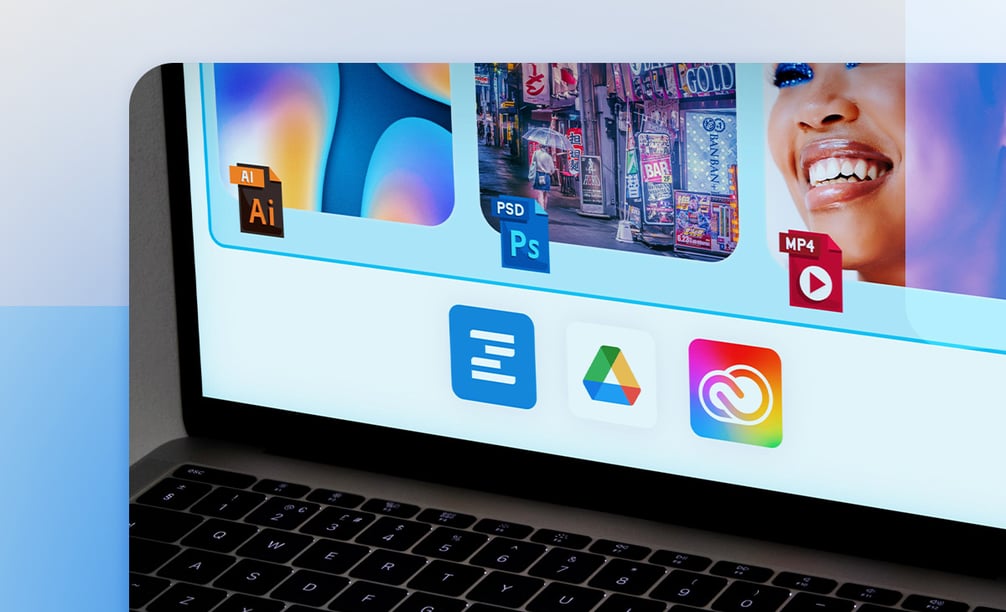Brand asset management plays a crucial role in improving the day-to-day work of both creative teams and creative operation managers.
A comprehensive brand asset management strategy lays a foundation for creatives to do their best work. It allows creatives to have the right files at their fingertips, provides reviewers with the latest version of a campaign asset, and ensures that every piece of creative that is shipped out the door meets brand standards.
However, brand asset management is a constant battle for creative teams. Organizations often have a vast number of brand assets, including logos, images, videos, documents, and more. Managing and organizing such a large volume of assets can be overwhelming, especially when they are scattered across various platforms, folders, or departments. Locating specific assets quickly becomes challenging without a centralized system in place.
Managing a diverse range of file types, such as JPEGs, PNGs, AI, PSD, and video formats, requires specific tools and systems that can handle and render each format appropriately. Ensuring consistent quality across various platforms and devices adds complexity to asset management.
In short, brand asset management enables your team to continually focus on brand identity–instead of tearing their hair out trying to find the right files all the time or working with outdated brand components.
Benefits of a comprehensive brand asset management strategy
Here’s why having a brand asset management policy and program in place is so important for creative teams:
It helps maintain consistency in brand identity
Brand asset management ensures consistency in brand identity across various marketing and communication channels. Creative teams work hard to establish and maintain a consistent brand image, and effective asset management enables them to achieve that. By centralizing and controlling brand assets, creative teams can ensure that everyone has access to the latest, approved assets, resulting in cohesive and unified brand messaging.
It builds a foundation for efficient collaboration and creative workflow
Creative teams often collaborate with various stakeholders, including designers, copywriters, marketers, and clients. Efficient brand asset management streamlines collaboration and workflow processes. It allows teams to access and share assets easily, reducing the time spent searching for files and improving productivity. Creative operations managers can oversee and optimize these processes, ensuring smooth collaboration and efficient asset utilization.
It creates time and cost savings across the creative process
Effective brand asset management saves time and reduces costs for creative teams and operations managers. With a centralized repository and streamlined processes, teams can quickly find and reuse existing assets instead of recreating them. This minimizes redundant work, accelerates project timelines, and improves resource allocation. Additionally, efficient management reduces the risk of using outdated or incorrect assets, avoiding costly rework or legal issues.
It standardizes version control and asset tracking
Creative teams constantly iterate and revise assets throughout the creative process. Brand asset management provides version control capabilities, allowing teams to track changes, compare versions, and maintain a clear record of asset iterations. This ensures that everyone works on the latest version and eliminates confusion caused by multiple versions floating around. Creative operations managers can monitor asset usage and track performance metrics, gaining insights into asset effectiveness and optimizing future campaigns.
It provides compliance and brand governance across all marketing activities
Compliance with brand guidelines and legal requirements is crucial for maintaining brand integrity and avoiding potential risks. Brand asset management facilitates compliance by providing control over who can access and use assets, ensuring that brand standards are upheld. Creative operations managers can enforce usage rights, permissions, and expiration dates, reducing the chances of unauthorized or incorrect asset usage.
It creates a foundation for project scalability and growth
As creative teams and operations grow, brand asset management becomes even more critical. A well-organized asset library ensures scalability by accommodating a larger volume of assets and supporting increased collaboration. Creative operations managers can implement workflows, permissions, and access controls that scale with the team's growth, enabling seamless collaboration and asset management.
How to manage brand asset efficiently at every stage of campaign launch
Brand asset management is more than just archiving files in a shared drive or creating a library of brand assets in a DAM system. It requires dedicated planning and system integration between source files, all your creative tools and project management tools, and a strong brand strategy.
Ideation and planning
During the ideation and planning stage, establishing a solid foundation for brand asset management is key. Here's how you can take control:
- Create a centralized asset repository: Implement a powerful digital asset management (DAM) system. This enables you to organize, store, and retrieve assets in one secure location from the very start. This centralized hub facilitates collaboration, version control, and access management.
- Set up permissions and access controls: Assign roles and permissions within your DAM system to control who can view, edit, and approve assets. This ensures that only authorized individuals have access to sensitive brand assets.
- Templating and automation: Utilize tools that allow you to create and manage templates for commonly-created assets, such as social media graphics or email newsletters. This saves time, ensures consistency, and minimizes errors, and means your team doesn't have to start from ground zero every time you want to plan or create a new campaign.
Drafting and production
During the creation and production stage, maintaining control over brand assets becomes even more crucial. Consider these tools and tips:
- Version control and asset tracking: Implement a system that supports version control, enabling you to track and compare changes and maintain a clear record of asset iterations.
- Asset metadata and tagging: Enhance searchability by adding relevant metadata and tags to your assets. Include information such as file type, keywords, descriptions, and copyright details. This helps streamline asset retrieval and improves overall SEO.
Creative review and approval
The review and approval stage is critical for maintaining quality and consistency. Consider the following tools and tips:
- Creative collaboration and proofing tools: Adopt an online proofing tool that facilitates seamless collaboration, annotation, and commenting on assets. This streamlines the review process, reduces approval cycles, and keeps everyone on the same page. Detailed markup capabilities are key for pinpointing specific errors or changes within brand elements and reviewing for brand consistency.
- Approval workflows and notifications: Leverage automated approval workflows to ensure timely feedback and minimize bottlenecks. Set up notifications to keep stakeholders informed about asset status changes, ensuring efficient decision-making.
Asset distribution and archiving
Once your assets are approved, controlling their distribution and archiving is essential. Consider these tools and tips:
- Asset distribution management: Use a DAM system that allows you to control access and distribution channels for your brand assets. This ensures that only authorized individuals or platforms can use and share your assets.
- Asset archiving and retrieval: Implement an archiving system within your DAM to store and organize outdated or unused assets. This declutters your asset library and ensures that current assets are easily accessible.
Get ahead of brand asset management needs
With streamlined management of brand assets, creative and marketing teams can more easily achieve consistent branding, optimize resource allocation, ensure compliance, and support scalability. Creative teams can focus on their core tasks of ideation and creativity, while operations managers can ensure efficient workflows and resource utilization.
By following the strategies and utilizing tools like DAM systems and creative workflow software, you can streamline your asset management processes at every stage of the creative content production cycle.




